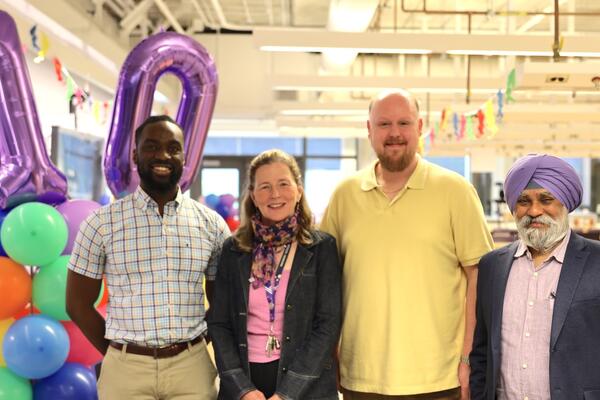
Designing her world
Architecture graduate goes beyond the books to forge her path

Architecture graduate goes beyond the books to forge her path
By Charlotte Danby Faculty of EngineeringThe daughter of two professional violinists, Danielle Grabke was exposed to thoughtfully designed environments from a very young age.
Her childhood memories recall many excursions to the Four Seasons Centre for the Performing Arts in Toronto — she has seen over a dozen performances of the Nutcracker and still finds new ways to love it. What struck her most as a child, though, was how the building itself contributed to her enjoyment of what she was watching.
“Every time I stepped inside, I was impacted by the design of the space and how it made me feel, which contributed enormously to my overall experience,” Grabke says. “As I got older, I wanted to learn and understand how to create spaces with positive atmospheres that make for memorable experiences.”
Her passion and curiosity eventually led Grabke to the University of Waterloo where on Saturday she will cross the stage at convocation to mark the completion of her Bachelor of Architectural Studies (BAS). Armed with her degree in architecture, Grabke stands out as a student who believes in getting the most from experiences — be that a theatre show or her studies.
Her enthusiastic energy, outgoing nature and career ambitions made for five very busy and rewarding undergraduate years. Without pause, she has kicked off her Master of Architecture (MArch) degree at Waterloo with the same “all-in” attitude.
La dolce vita
Grabke got involved in extracurricular student initiatives and clubs from first year. She was involved with student council, including a stint as president, and volunteers her time generously to her peers.
She is also the Director of BRIDGE, a student-led initiative that works to build stronger ties within the School of Architecture between students, professors and alumni, as well as with the Cambridge community where it is located.
“Our program emphasizes the importance of designing with impact,” Grabke says. “The more we as architects engage with each other, the community and the built environment around us, the better we can create beautiful and functional solutions.”
This notion underpins one of the course’s highlights available to all fourth-year students — a three-month immersive experience in Rome at the University of Waterloo’s studio in Trastevere. Grabke recalls her time there as invaluable and eye-opening, challenging her skills to create designs that fit seamlessly with such a historically dense city.
Working 9 to 5
Grabke credits her four co-op work experiences at architectural firms in Toronto, New York, Vancouver and Montreal with preparing her for her future career as well as adult life.
In her first co-op, Grabke was assigned to a female supervisor at an otherwise all-male firm. Architecture, like many fields, has a history of male dominance and some outdated attitudes still exist in its workplaces. As a student, she wasn’t sure what to expect going into the office on that first day. But working for a woman who has successfully navigated her career and wants other female architects to succeed, too, was enormously empowering.
“That first co-op helped me develop important interpersonal skills and workplace savviness,” Grabke says. “With each co-op that’s followed, I’ve become more confident and knowledgeable – and I want to help other aspiring architects feel the same way.”
Paying it forward
The Mentorship Architecture Peers program, run by architecture students, is another initiative that Grabke is passionate about. She takes her role as a peer mentor seriously, sharing as much of her knowledge and experience as she can to help undergrad students apply for co-op positions and navigate their studies successfully.
“Undergrad was hard!” Grabke exclaims. “Some advice for any overwhelmed architectural undergrads — ask your fellow students in upper years for help. We know what you’re going through and can give you valuable guidance. Our school is small so it’s easy to mix with people from different cohorts - just walk up to someone at their desk and say hello.”
Watch this space
Once she’s completed her master’s degree, Grabke plans to get a job, do her time as an intern and take the required exams to become a licensed architect. From there, she wants to chart a career that focuses on the nexus between architecture and interior design — how the overall look and feel of a building, both inside and out, affects how people engage with it.
“I hope my career is as fulfilling as my studies have been — and continue to be,” says Grabke. “I believe that getting involved to give back and help others, be that at university or work, contributes to success and I’m grateful for all the opportunities I’ve had so far.”

Read more
Here are the people and events behind some of this year’s most compelling Waterloo stories

Read more
The Pearl Sullivan Engineering IDEAs Clinic marks a decade of delivering experiential learning embedded in the real world and mentored by industry professionals

Read more
From co-op to community, grads offer insights and inspiration for the next generation of students
The University of Waterloo acknowledges that much of our work takes place on the traditional territory of the Neutral, Anishinaabeg, and Haudenosaunee peoples. Our main campus is situated on the Haldimand Tract, the land granted to the Six Nations that includes six miles on each side of the Grand River. Our active work toward reconciliation takes place across our campuses through research, learning, teaching, and community building, and is co-ordinated within the Office of Indigenous Relations.